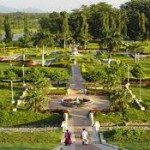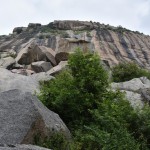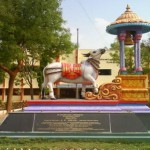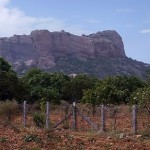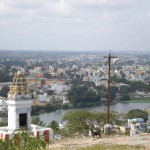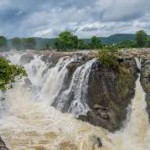| Krishnagiri Districts |
| About: |
| Krishnagiri District has a prehistoric importance. Archaeological sources confirm the presence of habitats of man kind during Paleolithic, Neolithic and Mesolithic Ages. Various rock paintings and rock carvings of Indus Valley civilization and Iron Age seen in this district support the historical significance of this district. The heart of Krishnagiri,Kaveripattinam,Hosur and Uthangarai were known as ‘Eyil Nadu’, ‘Murasu Nadu’ and ‘Kowoor Nadu’ respectively. During the Chola period, Krishnagiri region was called ‘Nigarili Chola Mandlam’ and ‘Vidhugadhazhagi Nallur’. Under the Nulamba rule it was popular as ‘Nulambadi’ according to historical sources. Hero stones were erected for those whose lost their lives in pursuit of adventure. There was a tradition of erecting memorial stones for people who sacrifice their lives for the sake of their kings since Sangam age. These memorial stones were called ‘Navagandam’. Plenty of memorial stones available in this district speak volumes about the valour and virtues of the people.A mint was established at Krishnagiri in 1794 AD. Gold, silver and copper coins were forged here. Rayakottai once the strong hold of British lost its importance for defense by 1880 AD. Many soldiers from Krishnagiri region took part in the world war and lost their lives. Even today a large number of youth from this Krishnagiri district are in the service of our Mother Land. Many patriots and sons of this soil participated in the nations freedom struggle. One among them was the “Wise Old Man, Dr .C. Raja Gopalachari”, who hailed from a small village in this district rose to the highest position in the nation as the first Governor General of independent India and also as Chief Minister.The important crops of Krishnagiri District are Paddy, Maize, Ragi, Banana, Sugarcane, Cotton, Tamarind, Coconut, Mango, Groundnut, Vegetables and Flowers. The district has an excellent scope for agri business. Regional Agricultural Research Center of Tamil Nadu Agricultural University is functioning efficiently at Paiyur in Kaveripattinam union since 1973 AD. This center is functioning in 18.5 hec. of land. It helps the peasants to develop and adopt the modern technique of cultivation. It has developed hybrid seeds by research which yields more tonnage and good quality.The holy land of wise scholars, men of valour and courage, blessed with the green valleys, hills and hillocks and inhabited by people known for innovative farming was divided, for the formation of Krishnagiri district, carved out of Dharmapuri district as 30th district of Tamil Nadu.’Krishna’ refers to ‘black’ and ‘giri’ refers to ‘hill’. This district is gifted with black granite hillocks and named as “krishnagiri”.The region came under the rule of Krishna Deva Raya and hence it might have been named after this king.Street lighting in rural areas is vested with the Panchayat Administration. The panchayats looks after the erection of new streetlights in the hamlets, payment of current consumption charges from the panchayat funds. Also the Procurement of tube lights, sodium vapor lights and other electrical appliances are done by the connected Panchayats itself. Now solar lights are also being utilized to cut down on consumption cost. Overall, 95% of the hamlets are covered under Rural Electrification.In Mysore war II after the “Treaty of Srirangapattinam” entire region of Salem and Barah Mahal were surrendered to the British. In 1792 AD, Captain Alexander Reed became the first District Collector of this region. Under the diplomacy of Robert Clive, the then Governor of Madras Presidency, Krishnagiri became the headquarters of Bara Mahal. |
| Krishnagiri district is bounded by Vellore and Thiruvannamalai districts in the East, Karnataka state in the west, State of Andhra Pradesh in the North Dharmapuri District in the south. Its area is 5143 Sq. Kms. This district is elevated from 300m to 1400m above the mean sea level. It is located between 11º 12’N to 12º 49’N Latitude,77º 27’E to 78º 38’E Longitude. Eastern part of the district experiences hot climate and Western part has a contrasting cold climate. the average rainfall is 830 mm per annum. March – June is summer season. July – November is Rainy Season and between December – February winter prevails. Three languages namely Tamil, Telugu and Kannada are predominantly spoken in this district. Major religions are Hindu, Islam and Christianity. This district stands as an ideal exhibit of National integration and religious harmony. The society exhibit the confluence of different languages and religions. |
| Location info: |
| Krishnagiri District,Tamil Nadu,India |
| Climate/Weather of Krishnagiri Districts: |
| Hot climate and Western part has a contrastingCold climate. the average rainfall is 830 mm per annum. March – June is summer season. July – NovemberRainy Season and between December – February winter prevails |
| History of Krishnagiri Districts: |
| The Krishnagiri district has prehistoric importance. Archeological sources confirm the presence of habitats of man kind during Paleolithic, Neolithic and Mesolithic Ages. Various rock paintings and rock carvings of Indus Valley civilization and Iron Age seen in this district support the historical significance of this district. The heart of ‘Krishnagiri’, ‘Hosur’ and ‘Uthangarai’ were known as ‘Eyil Nadu’, ‘Murasu Nadu’ and ‘Kowoor Nadu’ respectively. During Chola period, Krishnagiri region was called ‘Nigarili Chola Mandlam’ and ‘Vidhugadhazhagi Nallur’. Under ‘Nulamba’ rule it was popular as ‘Nulambadi’ according to historical sources.Hero stones were erected for those whose lost their lives in pursuit of adventure. There was a tradition of erecting memorial stones for people who sacrifice their lives for the sake of their kings since ‘Sangam Age’. These memorial stones were called ‘Navagandam’. Plenty of memorial stones available in this district speak volumes about the valour and virtues of the people. Part of Salem, Dharmapuri, Krishnagiri and Mysore were together named as “Thagadur Nadu” in Sangam Age. “Adhiayaman”, the noble king offered ‘Karunelli’ (Goose Berry) to the great poetess “Avvaiyar” who adorned his court for her long life. Krishnagiri was once ruled by Adhiyaman and hence also known as ‘Adhiayaman Nadu’. This region was ruled by Pallavas, Gangas, Nulambas, Cholas, Hoysalas, Vijaya Nagar Emperors, Bijapur Sultans, Wudayars of Mysore and Nayaks of Madurai.This region of Krishnagiri served as gateway of Tamil Nadu and the protective barrier for Sourthern region defending onslaughts from barriers with motives of imperialism and exploitation. Twelve Forts in this region were popularly known as ‘Bara Mahal’ Forts. These forts have borne the funs of many attacks by Mysore and Andhra rulers. Krishnagiri Fort become the first and forth most defensive place. The majestic fortress built on Krishnagiri hill by the Vijaya Nagar Emperors, stands as testimony still now. ‘ “Kundani” a place in Krishnagiri District was once the Head Quarters of the Hoysala king ‘Veera Ramanathan’ in 13th Centuty AD. ‘Jagadevarayan’, Hoysala kind made’Jagadevi’ (one of the ‘Bara Mahal’ forts) as his capital. |
| Educational Institutions of Krishnagiri Districts: |
| Name of the Institute:Government Arts College ,Krishnagiri Government (W) Arts College, Krishnagiri Annai Sathiya Government Arts College (Women) Arabic College, Krishnagiri Government Engineering College, Bargur Adiyaman Eng. College, Hosur R.E.T.C. Krishnagiri Women Arts College, Bargur District Institute of Teachers Education Perumal Manimekalai Arts College Hosur POLYTECHNIC Government Ploytechnic, Krishnagiri Government Community Polytechnic, Krishnagiri Government IRT Polytechnic, Krishnagiri I.T.I Sakthi I.T.I. Bharathi I.T.I Govt. I.T.I. Sapthagiri I.T.I. Govt. I.T.I. Hosur |
| Langauge |
| Three languages namely Tamil, Telugu and Kannada are predominantly spoken in this district. |
| Culture: |
| Tamil Nadu finds a prime position on the cultural map of the country. The state’s contribution to literature, music, arts of Indian classical culture is praiseworthy. Dance, music, art and crafts and celebration of various festivals form important parts of Tamil culture. The various fairs and festivals are celebrated with great enthusiasm. Tamil people have their own living style which is reflected in their food, costumes, language and folk art and culture. Let’s find more about thecultural heritages of the state..Mango Festival:Krishnagiri is the venue for this famous festival, celebrated on the last 3 days of June. An event for the buyers and sellers to meet, various mangoes are kept on display at this festival.Car festival:Held in the month of May every year at nearby Denkanikottai, this popular festival is thronged by hordes of devotees. |
| How to reach? |
| Nearest Railway Station: Hosur Railway Station (5 km). |
| Nearest Airport:Bangalore Airport (40 km). |
| Road Transport:Krishnagiri is well-connected by Prime Minister’s Golden Rectangle Project executed by National Highways Authority of India. |
| Tourist Attraction of Krishnagiri Districts: |
| Krishnagiri Reservoir Project: KRP dam is situated at a distance of 7 Kms from Krishnagiri. It is in between Dharmapuri and Krishnagiri. Thousands of acres of land around Krishnagiri is irrigated with the help of this dam. This is a famous tourist spot too. This dam is flooded with tourists during the week ends.Thali-Littele England: This place is about 25 Kms from Hosur. It is at the border of Tamil Nadu adjoining Karnataka. It is situated in the land of valleys and cliffs. The climate is very cool and pleasant. It experiences cold and cloudy weather resembling England. Hence it is popular with the name ‘Little England’ since British Regime. The area is covered by a number of hills. The climate is chill round the year. It is called Little England. The taluk headquarters is Denkanikottai. The fort at Denkanikottai is built by Palayakarar in 1530 AD. The fort is destroyed during war with Hyder Ali and Tippu Sultan. There is a temple for Venugopala Swami. Car festival is held during the month of May every year. Thousands of devotees visit during this festival.Kelevarapalli Reservoir Project: Construction of this project was completed in 1995 AD. It is situated at a distance of 10Kms from Hosur. It is only 8 Kms away from Karnataka state. This has become a picnic spot for citizens of Hosur area. Tourists from adjoining state often visit this place on holidays.Government Museum: The presence of museum in this District is known for traditional culture, Art and Architecture, Heritage and Historical Background is a blessing in disguise, to spread the traditional and heritage, culture and art of Tamil Nadu and Krishnagiri District in particular. This museum is functioning since 1993 AD, situated on Gandhi Salai in Krishnagiri. Historical monuments are preserved and exhibited here. It is not only a place of tourism but also a center of education. This museum collects the monuments, Classifies and preserves them to conduct research on it’s historical worthiness.Rajaji Memorial -Thorapalli: In memory of the great leader Rajaji, the Tamil Nadu Government has converted the house in Thorapalli where Rajaji was born, as a memorial. It is located 10 Km from Hosur near Onnalvadi. Some of his belongings and a photo gallery depicting his various walks of life are displayed here.Rayakottah: Rayakottah, a hill fort, situated at a distance of 30 Km from Hosur marks the border of the Palghat plateau. Even after the Mysore wars, for the British it was a strategic place where their troops were stationed till 1861. The ramparts and the bastions of the fort are more or less intact. The fort is a protected monument.Mallachandram: It is located 19 km from krishnagiri and 4 km from samalpallam. Samalpallam lies on the krishnagiri-Bangalore Road N.H 7.The Ancestors cult was worshiped by the Megalithic people in the ancient period. In krishnagiri District three kinds of memorials are observed and they were named a Cairn circle, Dolmen and Urnburials.In Mallachandram more than 100 Dolmens are identified in the Moral Pari. Four types of dolmens in this single place. Dolmen built of four vertical orthostats with a huge round cap stone is covered by the top.In the second type there are double circles made of vertical slabs and the fort hole is found in the eastern side of the dolmen. The tall vertical slab is in semi-circular top. This is one of the important dolmen found in Tamil nadu.Third one is having the similar architectural form of the second type of dolmen. But the port hole and passage are raised up to the port hole level. Smaller dolmens are rercted around the big dolmen. In other words a big dolmen was surrounded by the small dolmens. It looks like a group of people found around the head man.Arulmigu Maragathambigai Chandra Choodeswara Temple: This temple is located in Hosur on NH-7. Most of the pilgrims are from Karnataka state. This temple stands on a hillock beside this temple a children’s park and a observatory is setup by the tourism department. A guest house is also functioning under the control of Tamil Nadu tourism which is very near to the hillock.Hanumanthathirtham: This place is situated on the bank of Pennaiyar at a distance of 10 Km from Uthangarai and traditionally associated with Tirtamalai. It is believed that Hanuman who was instructed by Lord Rama to get the water from the Ganges for his penance at Tirtamalai which he could not do it in time. So Rama was said to have done Asthrapryogam and got it. Disappointed at this, Hanuman was said to have thrown down the vessel in which he brought the holy water and this spilled water is believed to be the ‘Hanumantirtham’. The water is considered sacred and during the Tamil month of Aadi (July-August) people frequent this spot. |
| Hotels/Lodge/Accommodation in Krishnagiri Districts: |
| Annapurna Hotel:Bangalore Road, Krishnagiri, Tamil NaduAnnapurna Veg Hotel:Bangalore Road, Krishnagiri, Tamil NadClassic Hotel:Bangalore Road, Krishnagiri, Tamil NaduAryabhavan Hotel:Krishnagiri, Tamil NaduTamil Nadu Hotel:Krishnagiri, Tamil NaduVasavi Vegetarian Hotel:Krishnagiri, Tamil NaduMainas Hotel:Krishnagiri, Tamil Nadu |
| Links: |
| http://www.krishnagiri.tn.nic.in/profile.htmhttp://tamilnaduonline.in/Profile/ |
